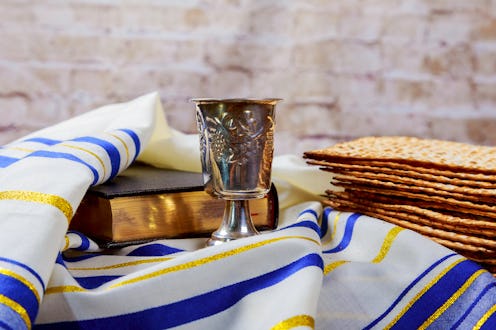
Growing up half-Jewish, there were a few holidays that my mom made sure that my sister and I were knowledgeable about, and Passover was one of them. Passover is celebrated in the early spring, typically close to Easter, and is meant to commemorate the freedom of the Israelites from slavery back in Ancient Egypt. Many people who don't celebrate don't know how long Passover lasts — while they might be familiar with the Seder, which occurs on the first night of Passover, they may not realize that the holiday actually lasts for seven days in Israel, and eight days outside of Israel.
Passover is celebrated on the 15th of the Jewish month Nisan, beginning this year on the evening of Friday, April 22, and ending on the evening of Saturday, April 30. As mentioned, the Seder is celebrated on the first night, but some Jews have two nights of this tradition, which includes reading stories from The Book of Exodus and partaking in rituals which include wine (or grape juice, for those underage) and matzoh (also spelled as matzo and matzah), a brittle flatbread. During Passover, there are many symbolic foods in which the family partakes in, and the Seder categorizes each in order from "slavery" to "freedom."
There are actually two separate parts to Passover. The first two days and last two days, known as yom tov, include celebratory holiday meals and candles, and traditional Jews celebrate by not working, driving, and even abstaining from use of electricity, as they're required to "light no fire" — although today, some Jews may choose to disregard that last one. Yom tov usually also means getting a fresh haircut and baking some fresh challah (the day before, of course) to celebrate. The middle four days are known as "chol hamoed", which translates into "weekdays [of] the festival." During chol hamoed days, Jews are allowed to work. To honor the past, Jews also have a "no chametz" rule which lasts throughout the holiday, with "chametz" meaning "leveling grain." As the Jews were in a hurry to leave Egypt, they couldn't sacrifice any time waiting for their bread to rise, which is why matzoh is typically eaten, and why all cakes, breads, and cookies should be avoided. Instead, foods like quinoa can be substituted in.
So, why is Passover eight days long? Well, back in the day, the months of the Jewish calendar were based upon the new crescent moon. Lunar months are typically 29.5 days, which is why months on the Jewish calendar are between 29 and 30 days long. Two witnesses were present to witness the moon, and Jews were then informed of the new month by signal fires. But as time went on, this was changed up — some troublemakers decided to set their own off, which lead to a bit of confusion. Eventually the message was spread by word of mouth, which as you can imagine, took quite some time — not everyone got the message as to when certain celebrations would be. Around the 1960s, rabbis were told to choose whether or not yom tov would be one or two days long, which is why the days of Passover vary between communities, with eight being the most common. Ben Dreyfus, a writer over at Reform Judaism, suggests that it makes the most sense having a second Seder during the seventh night, which is definitely considered a day of yom tov, as this would be convenient for those who want to celebrate Passover with family that might not be too local.
Passover, in general, is a time for family and the celebration of both history, and the start of spring, and most spend this time together to honor how far they've come. If you're celebrating Passover, or invited to your first Passover Seder, be prepared to learn a lot, be introduced to a lot of amazing food, and learn so much about the Jewish culture.
Images: Fotolia; Giphy